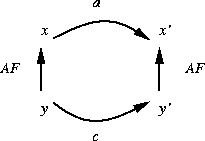- Define an abstraction function
to relate concrete states with abstract states.

- Define a representation (sometimes called concrete)
invariant,
that characterizes the domain of AF. This predicate prunes down the set of concrete states,

 , to only those of interest (only those
that represent some abstract state in
, to only those of interest (only those
that represent some abstract state in  ).
After you define this predicate, you must prove that it indeed is an
invariant.
You may use the technique presented in the Reasoning About
State Machines handout to show this.
).
After you define this predicate, you must prove that it indeed is an
invariant.
You may use the technique presented in the Reasoning About
State Machines handout to show this.
- For each
 (for all initial states in
(for all initial states in  ) show:
This requires showing that each initial state of the concrete machine is some initial state of the abstract machine.
) show:
This requires showing that each initial state of the concrete machine is some initial state of the abstract machine.
- For each state transition
 of the concrete machine C where y satisfies RI,
there must exist a state transition
of the concrete machine C where y satisfies RI,
there must exist a state transition  of the abstract machine A.
To show this, it suffices to show
the following
commutative relationship holds:
of the abstract machine A.
To show this, it suffices to show
the following
commutative relationship holds:

where x = AF(y), x' = AF(y') and
 .
Here's how to read the diagram: Put both index fingers at the concrete
state y; move your right one to the right (performing the concrete
action c) and then up (applying AF to the new concrete state y');
move your left one up (applying AF to y) and then to the right
(performing the corresponding abstract action
.
Here's how to read the diagram: Put both index fingers at the concrete
state y; move your right one to the right (performing the concrete
action c) and then up (applying AF to the new concrete state y');
move your left one up (applying AF to y) and then to the right
(performing the corresponding abstract action  ; you
should end up in the same place: the abstract state, x'.
; you
should end up in the same place: the abstract state, x'.